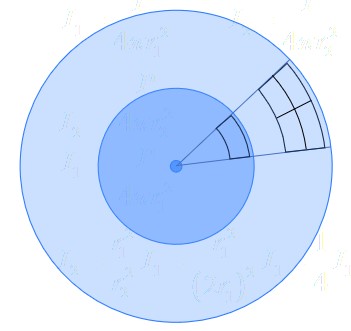Section 16.6 Wave Intensity
Exercises Warm-up Activity
1. Exploring Loudness.
You hear a loud noise. Which wave property or properties (frequency, wavelength, wave speed, amplitude, wave number, phase, etc.) do you think is related to how loud it is?
Consider a transverse wave on a horizontal string. Any point along the string moves up and down as a wave passes through it. The average speed of a point on the string is related to the amplitude of the wave and also to how quickly the motion changes from up to down – thus the frequency.
\begin{equation*}
K = \frac{1}{2}mv^2
\end{equation*}
\begin{equation*}
E \propto f^2 A^2
\end{equation*}
The kinetic energy of the mass at that point depends on the square of the speed. We can infer that the energy of the wave goes as the square of the amplitude, and the square of the frequency.
Definition 16.6.1. Intensity.
The intensity of a wave emanating from a point source is the power per unit area:
\begin{equation*}
I = \frac{P}{\text{Area}}
\end{equation*}
where \(P\) is power and the area is the surface area of a sphere.
Exercises Activities
1. Explanation - Distance and Intensity.
Your friend is a distance \(d\) from a point source of sound and measures the intensity of the sound wave to be \(I\text{.}\) How far away from the source of the wave do you need to be to measure the intensity to be \(\frac{I}{2}\text{?}\)
References References
[1]
